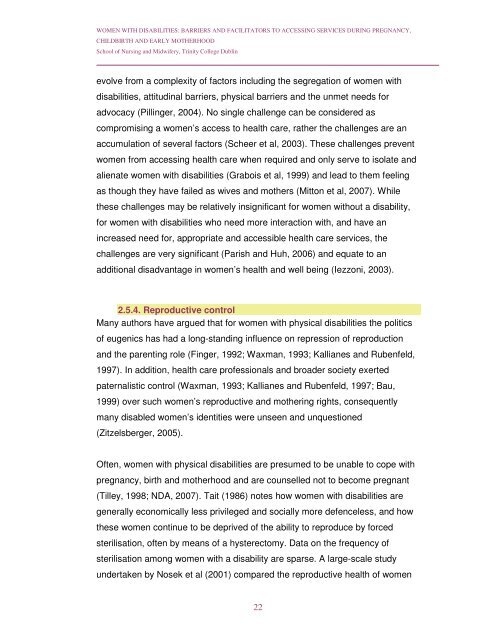Women with Disabilities: Barriers and Facilitators to Accessing ...
Women with Disabilities: Barriers and Facilitators to Accessing ...
Women with Disabilities: Barriers and Facilitators to Accessing ...
Create successful ePaper yourself
Turn your PDF publications into a flip-book with our unique Google optimized e-Paper software.
WOMEN WITH DISABILITIES: BARRIERS AND FACILITATORS TO ACCESSING SERVICES DURING PREGNANCY,CHILDBIRTH AND EARLY MOTHERHOODSchool of Nursing <strong>and</strong> Midwifery, Trinity College Dublinevolve from a complexity of fac<strong>to</strong>rs including the segregation of women <strong>with</strong>disabilities, attitudinal barriers, physical barriers <strong>and</strong> the unmet needs foradvocacy (Pillinger, 2004). No single challenge can be considered ascompromising a women’s access <strong>to</strong> health care, rather the challenges are anaccumulation of several fac<strong>to</strong>rs (Scheer et al, 2003). These challenges preventwomen from accessing health care when required <strong>and</strong> only serve <strong>to</strong> isolate <strong>and</strong>alienate women <strong>with</strong> disabilities (Grabois et al, 1999) <strong>and</strong> lead <strong>to</strong> them feelingas though they have failed as wives <strong>and</strong> mothers (Mit<strong>to</strong>n et al, 2007). Whilethese challenges may be relatively insignificant for women <strong>with</strong>out a disability,for women <strong>with</strong> disabilities who need more interaction <strong>with</strong>, <strong>and</strong> have anincreased need for, appropriate <strong>and</strong> accessible health care services, thechallenges are very significant (Parish <strong>and</strong> Huh, 2006) <strong>and</strong> equate <strong>to</strong> anadditional disadvantage in women’s health <strong>and</strong> well being (Iezzoni, 2003).2.5.4. Reproductive controlMany authors have argued that for women <strong>with</strong> physical disabilities the politicsof eugenics has had a long-st<strong>and</strong>ing influence on repression of reproduction<strong>and</strong> the parenting role (Finger, 1992; Waxman, 1993; Kallianes <strong>and</strong> Rubenfeld,1997). In addition, health care professionals <strong>and</strong> broader society exertedpaternalistic control (Waxman, 1993; Kallianes <strong>and</strong> Rubenfeld, 1997; Bau,1999) over such women’s reproductive <strong>and</strong> mothering rights, consequentlymany disabled women’s identities were unseen <strong>and</strong> unquestioned(Zitzelsberger, 2005).Often, women <strong>with</strong> physical disabilities are presumed <strong>to</strong> be unable <strong>to</strong> cope <strong>with</strong>pregnancy, birth <strong>and</strong> motherhood <strong>and</strong> are counselled not <strong>to</strong> become pregnant(Tilley, 1998; NDA, 2007). Tait (1986) notes how women <strong>with</strong> disabilities aregenerally economically less privileged <strong>and</strong> socially more defenceless, <strong>and</strong> howthese women continue <strong>to</strong> be deprived of the ability <strong>to</strong> reproduce by forcedsterilisation, often by means of a hysterec<strong>to</strong>my. Data on the frequency ofsterilisation among women <strong>with</strong> a disability are sparse. A large-scale studyundertaken by Nosek et al (2001) compared the reproductive health of women22
















